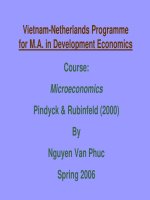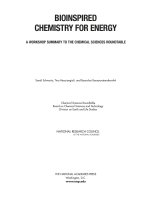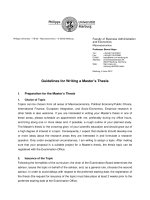DIETARY REFERENCE INTAKES FOR Vitamin A, Vitamin K, Arsenic, Boron, Chromium, Copper, Iodine, Iron, Manganese, Molybdenum, Nickel, Silicon, Vanadium, and Zinc
Bạn đang xem bản rút gọn của tài liệu. Xem và tải ngay bản đầy đủ của tài liệu tại đây (12.43 MB, 797 trang )
NATIONAL ACADEMY PRESS
Washington, D.C.
A Report of the
Panel on Micronutrients,
Subcommittees on Upper Reference Levels of Nutrients and of
Interpretation and Uses of Dietary Reference Intakes, and the
Standing Committee on the Scientific Evaluation of
Dietary Reference Intakes
Food and Nutrition Board
Institute of Medicine
DRI
DIETARY REFERENCE INTAKES
FOR
Vitamin A,
Vitamin K,
Arsenic, Boron,
Chromium,
Copper,
Iodine, Iron,
Manganese,
Molybdenum,
Nickel, Silicon,
Vanadium,
and Zinc
Copyright © National Academy of Sciences. All rights reserved.
Dietary Reference Intakes for Vitamin A, Vitamin K, Arsenic, Boron, Chromium, Copper, Iodine, Iron, Manganese, Molybdenum, Nickel, Silicon, Vanadium, and Zinc
/>NATIONAL ACADEMY PRESS • 2101 Constitution Avenue, N.W. • Washington, DC 20418
NOTICE: The project that is the subject of this report was approved by the Governing Board
of the National Research Council, whose members are drawn from the councils of the
National Academy of Sciences, the National Academy of Engineering, and the Institute of
Medicine. The members of the committee responsible for the report were chosen for their
special competences and with regard for appropriate balance.
This project was funded by the U.S. Department of Health and Human Services Office of
Disease Prevention and Health Promotion, Contract No. 282-96-0033, T03; the National
Institutes of Health Office of Dietary Supplements; the Centers for Disease Control and
Prevention, National Center for Chronic Disease Prevention and Health Promotion, Division
of Nutrition and Physical Activity; Health Canada; the Institute of Medicine; the Dietary
Reference Intakes Private Foundation Fund, including the Dannon Institute and the Inter-
national Life Sciences Institute; and the Dietary Reference Intakes Corporate Donors’ Fund.
Contributors to the Fund to date include Daiichi Fine Chemicals, Inc., Kemin Foods, L.C.,
M&M/Mars, Mead Johnson Nutritionals, Nabisco Foods Group, Natural Source Vitamin E
Association, Roche Vitamins Inc., U.S. Borax, and Weider Nutritional Group. The opinions
or conclusions expressed herein do not necessarily reflect those of the funders.
Library of Congress Cataloging-in-Publication Data
Dietary reference intakes for vitamin A, vitamin K, arsenic, boron, chromium, copper,
iodine, iron, manganese, molybdenum, nickel, silicon, vanadium, and zinc : a report of
the Panel on Micronutrients [et al.], Standing Committee on the Scientific Evaluation
of Dietary Reference Intakes, Food and Nutrition Board, Institute of Medicine.
p. cm.
Includes bibliographical references and index.
ISBN 0-309-07279-4 (pbk.)—ISBN 0-309-07290-5 (hc.)
1. Trace elements in nutrition. 2. Vitamin A in human nutrition. 3. Vitamin K. 4.
Reference Values (Medicine) I. Institute of Medicine (U.S.). Panel on Micronutrients.
QP534 .D54 2002
612.3′924 dc21 2001052139
This report is available for sale from the National Academy Press, 2101 Constitution Avenue,
N.W., Box 285, Washington, DC 20055; call (800) 624-6242 or (202) 334-3313 (in the
Washington metropolitan area), or visit the NAP’s on-line bookstore at .
For more information about the Institute of Medicine or the Food and Nutrition Board, visit
the IOM home page at .
Copyright 2001 by the National Academy of Sciences. All rights reserved.
Printed in the United States of America
The serpent has been a symbol of long life, healing, and knowledge among almost all cultures
and religions since the beginning of recorded history. The image adopted as a logotype by
the Institute of Medicine is based on a relief carving from ancient Greece, now held by the
Staatliche Museen in Berlin.
Copyright © National Academy of Sciences. All rights reserved.
Dietary Reference Intakes for Vitamin A, Vitamin K, Arsenic, Boron, Chromium, Copper, Iodine, Iron, Manganese, Molybdenum, Nickel, Silicon, Vanadium, and Zinc
/>“Knowing is not enough; we must apply.
Willing is not enough; we must do.”
—Goethe
Shaping the Future for Health
INSTITUTE OF MEDICINE
Copyright © National Academy of Sciences. All rights reserved.
Dietary Reference Intakes for Vitamin A, Vitamin K, Arsenic, Boron, Chromium, Copper, Iodine, Iron, Manganese, Molybdenum, Nickel, Silicon, Vanadium, and Zinc
/>The National Academy of Sciences is a private, nonprofit, self-perpetuating society
of distinguished scholars engaged in scientific and engineering research, dedicated
to the furtherance of science and technology and to their use for the general
welfare. Upon the authority of the charter granted to it by the Congress in 1863,
the Academy has a mandate that requires it to advise the federal government on
scientific and technical matters. Dr. Bruce M. Alberts is president of the National
Academy of Sciences.
The National Academy of Engineering was established in 1964, under the charter
of the National Academy of Sciences, as a parallel organization of outstanding
engineers. It is autonomous in its administration and in the selection of its members,
sharing with the National Academy of Sciences the responsibility for advising the
federal government. The National Academy of Engineering also sponsors engi-
neering programs aimed at meeting national needs, encourages education and
research, and recognizes the superior achievements of engineers. Dr. Wm. A.
Wulf is president of the National Academy of Engineering.
The Institute of Medicine was established in 1970 by the National Academy of
Sciences to secure the services of eminent members of appropriate professions in
the examination of policy matters pertaining to the health of the public. The
Institute acts under the responsibility given to the National Academy of Sciences
by its congressional charter to be an adviser to the federal government and, upon
its own initiative, to identify issues of medical care, research, and education.
Dr. Kenneth I. Shine is president of the Institute of Medicine.
The National Research Council was organized by the National Academy of Sciences
in 1916 to associate the broad community of science and technology with the
Academy’s purposes of furthering knowledge and advising the federal government.
Functioning in accordance with general policies determined by the Academy, the
Council has become the principal operating agency of both the National Academy
of Sciences and the National Academy of Engineering in providing services to the
government, the public, and the scientific and engineering communities. The
Council is administered jointly by both Academies and the Institute of Medicine.
Dr. Bruce M. Alberts and Dr. Wm. A. Wulf are chairman and vice chairman,
respectively, of the National Research Council.
National Academy of Sciences
National Academy of Engineering
Institute of Medicine
National Research Council
Copyright © National Academy of Sciences. All rights reserved.
Dietary Reference Intakes for Vitamin A, Vitamin K, Arsenic, Boron, Chromium, Copper, Iodine, Iron, Manganese, Molybdenum, Nickel, Silicon, Vanadium, and Zinc
/>v
PANEL ON MICRONUTRIENTS
ROBERT RUSSELL (Chair), Jean Mayer U.S. Department of Agriculture
Human Nutrition Research Center on Aging, Tufts University,
Boston, Massachusetts
JOHN L. BEARD, Department of Nutrition, The Pennsylvania State
University, University Park
ROBERT J. COUSINS, Center for Nutritional Sciences, University of
Florida, Gainesville
JOHN T. DUNN, University of Virginia Health System, Charlottesville
GUYLAINE FERLAND, Department of Nutrition, University of Montreal,
Quebec, Canada
K. MICHAEL HAMBIDGE, Department of Pediatrics, University of
Colorado Health Sciences Center, Denver
SEAN LYNCH, Veterans Administration Medical Center, Hampton,
Virginia
JAMES G. PENLAND, U.S. Department of Agriculture Human Nutrition
Research Center, Grand Forks, North Dakota
A. CATHARINE ROSS, Department of Nutrition, The Pennsylvania State
University, University Park
BARBARA J. STOEKER, Department of Nutritional Sciences, Oklahoma
State University, Stillwater
JOHN W. SUTTIE, Department of Biochemistry, University of Wisconsin,
Madison
JUDITH R. TURNLUND, U.S. Department of Agriculture Western
Human Nutrition Research Center, Davis, California
KEITH P. WEST, Center for Human Nutrition, Johns Hopkins School of
Hygiene and Public Health, Baltimore, Maryland
STANLEY H. ZLOTKIN, Departments of Pediatrics and Nutritional
Sciences, The Hospital for Sick Children and The University of
Toronto, Ontario, Canada
Consultants
LEWIS BRAVERMAN, School of Medicine, Harvard University, Boston,
Massachusetts
FRANCOISE DELANGE, Department of Pediatrics, Hôpital Saint-Pierre,
Brussels, Belgium
Staff
PAULA R. TRUMBO, Study Director
ALICE L. VOROSMARTI, Research Associate
MICHELE RAMSEY, Senior Project Assistant
Copyright © National Academy of Sciences. All rights reserved.
Dietary Reference Intakes for Vitamin A, Vitamin K, Arsenic, Boron, Chromium, Copper, Iodine, Iron, Manganese, Molybdenum, Nickel, Silicon, Vanadium, and Zinc
/>vi
SUBCOMMITTEE ON UPPER REFERENCE
LEVELS OF NUTRIENTS
IAN C. MUNRO (Chair), CanTox, Inc., Mississauga, Ontario, Canada
GEORGE C. BECKING, Phoenix OHC, Kingston, Ontario, Canada
RENATE D. KIMBROUGH, Institute for Evaluating Health Risks,
Washington, D.C.
RITA B. MESSING, Division of Environmental Health, Minnesota
Department of Health, St. Paul
SANFORD A. MILLER, Graduate School of Biomedical Sciences,
University of Texas Health Sciences Center, San Antonio
HARRIS PASTIDES, School of Public Health, University of South
Carolina, Columbia
JOSEPH V. RODRICKS, The Life Sciences Consultancy LLC,
Washington, D.C.
IRWIN H. ROSENBERG, Clinical Nutrition Division, the Jean Mayer
U.S. Department of Agriculture Human Nutrition Research Center
on Aging, Tufts University and New England Medical Center, Boston,
Massachusetts
STEVE L. TAYLOR, Department of Food Science and Technology and
Food Processing Center, University of Nebraska, Lincoln
JOHN A. THOMAS, Retired, University of Texas Health Science Center
at San Antonio
GARY M. WILLIAMS, Department of Pathology, New York Medical
College, Valhalla
Staff
SANDRA SCHLICKER, Study Director
ELISABETH A. REESE, Research Associate
MICHELE RAMSEY, Senior Project Assistant
Copyright © National Academy of Sciences. All rights reserved.
Dietary Reference Intakes for Vitamin A, Vitamin K, Arsenic, Boron, Chromium, Copper, Iodine, Iron, Manganese, Molybdenum, Nickel, Silicon, Vanadium, and Zinc
/>vii
SUBCOMMITTEE ON INTERPRETATION AND USES OF
DIETARY REFERENCE INTAKES
SUZANNE MURPHY (Chair), Cancer Research Center of Hawaii,
University of Hawaii, Honolulu
LENORE ARAB, University of North Carolina School of Public Health,
Chapel Hill
SUSAN I. BARR, University of British Columbia, Vancouver
SUSAN T. BORRA, International Food Information Council,
Washington, D.C.
ALICIA CARRIQUIRY, Iowa State University, Ames
BARBARA L. DEVANEY, Mathematica Policy Research, Princeton,
New Jersey
JOHANNA T. DWYER, Frances Stern Nutrition Center, New England
Medical Center and Tufts University, Boston, Massachusetts
JEAN-PIERRE HABICHT, Cornell University, Ithaca, New York
HARRIET V. KUHNLEIN, Centre for Indigenous Peoples’ Nutrition and
Environment, McGill University, Ste. Anne de Bellevue, Quebec,
Canada
Staff
MARY POOS, Study Director
ALICE L. VOROSMARTI, Research Associate
SHELLEY GOLDBERG, Senior Project Assistant
Copyright © National Academy of Sciences. All rights reserved.
Dietary Reference Intakes for Vitamin A, Vitamin K, Arsenic, Boron, Chromium, Copper, Iodine, Iron, Manganese, Molybdenum, Nickel, Silicon, Vanadium, and Zinc
/>viii
STANDING COMMITTEE ON THE SCIENTIFIC
EVALUATION OF DIETARY REFERENCE INTAKES
VERNON R. YOUNG (Chair), Laboratory of Human Nutrition, School of
Science, Massachusetts Institute of Technology, Cambridge
JOHN W. ERDMAN, JR. (Vice-Chair), Division of Nutritional Sciences,
College of Agricultural, Consumer and Environmental Sciences,
University of Illinois at Urbana-Champaign
LINDSAY H. ALLEN, Department of Nutrition, University of California,
Davis
STEPHANIE A. ATKINSON, Department of Pediatrics, Faculty of Health
Sciences, McMaster University, Hamilton, Ontario, Canada
ROBERT J. COUSINS, Center for Nutritional Sciences, University of
Florida, Gainesville
JOHANNA T. DWYER, Frances Stern Nutrition Center, New England
Medical Center and Tufts University, Boston, Massachusetts
JOHN D. FERNSTROM, University of Pittsburgh School of Medicine,
Western Psychiatric Institute and Clinic, Pittsburgh, Pennsylvania
SCOTT M. GRUNDY, Center for Human Nutrition, University of Texas
Southwestern Medical Center, Dallas
SANFORD A. MILLER, Graduate School of Biomedical Sciences,
University of Texas Health Science Center, San Antonio
WILLIAM M. RAND, Department of Family Medicine and Community
Health, Tufts University School of Medicine, Boston, Massachusetts
U.S. Government Liaison
ELIZABETH CASTRO, Office of Disease Prevention and Health
Promotion, U.S. Department of Health and Human Services,
Washington, D.C.
Canadian Government Liaison
PETER W.F. FISCHER, Nutrition Research Division, Health Protection
Branch, Health Canada, Ottawa
Consultant
GEORGE BEATON, GHB Consulting, Willowdale, Ontario, Canada
Staff
ALLISON A. YATES, Study Director
SANDRA SCHLICKER, Senior Program Officer
MARY POOS, Senior Program Officer
Copyright © National Academy of Sciences. All rights reserved.
Dietary Reference Intakes for Vitamin A, Vitamin K, Arsenic, Boron, Chromium, Copper, Iodine, Iron, Manganese, Molybdenum, Nickel, Silicon, Vanadium, and Zinc
/>ix
PAULA TRUMBO, Senior Program Officer
ALICE L. VOROSMARTI, Research Associate
KIMBERLY FREITAG, Research Assistant
MICHELE RAMSEY, Senior Project Assistant
GAIL E. SPEARS, Administrative Assistant
Copyright © National Academy of Sciences. All rights reserved.
Dietary Reference Intakes for Vitamin A, Vitamin K, Arsenic, Boron, Chromium, Copper, Iodine, Iron, Manganese, Molybdenum, Nickel, Silicon, Vanadium, and Zinc
/>x
FOOD AND NUTRITION BOARD
CUTBERTO GARZA (Chair), Division of Nutrition, Cornell University,
Ithaca, New York
ALFRED H. MERRILL, JR. (Vice Chair), Department of Biochemistry,
Emory Center for Nutrition and Health Sciences, Emory University,
Atlanta, Georgia
ROBERT M. RUSSELL (Vice Chair), Jean Mayer U.S. Department of
Agriculture Human Nutrition Research Center on Aging, Tufts
University, Boston, Massachusetts
VIRGINIA A. STALLINGS (Vice Chair), Division of Gastroenterology and
Nutrition, The Children’s Hospital of Philadelphia, Pennsylvania
LARRY R. BEUCHAT, Center for Food Safety and Quality
Enhancement, University of Georgia, Griffin
BENJAMIN CABALLERO, Center for Human Nutrition, Johns Hopkins
School of Hygiene and Public Health, Baltimore, Maryland
FERGUS M. CLYDESDALE, Department of Food Science, University of
Massachusetts, Amherst
ROBERT J. COUSINS, Center for Nutritional Sciences, University of
Florida, Gainesville
JOHANNA T. DWYER, Frances Stern Nutrition Center, New England
Medical Center and Tufts University, Boston, Massachusetts
SCOTT M. GRUNDY, Center for Human Nutrition, University of Texas
Southwestern Medical Center, Dallas
SHIRIKI KUMANYIKA, University of Pennsylvania School of Medicine,
Philadelphia
LYNN PARKER, Child Nutrition Programs and Nutrition Policy, Food
Research and Action Center, Washington, D.C.
ROSS L. PRENTICE, Division of Public Health Sciences, Fred
Hutchinson Cancer Research Center, Seattle, Washington
A. CATHARINE ROSS, Department of Nutrition, The Pennsylvania State
University, University Park
ROBERT E. SMITH, R.E. Smith Consulting, Inc., Newport, Vermont
STEVE L. TAYLOR, Department of Food Science and Technology and
Food Processing Center, University of Nebraska, Lincoln
Staff
ALLISON A. YATES, Director
GAIL E. SPEARS, Administrative Assistant
GARY WALKER, Financial Associate
Copyright © National Academy of Sciences. All rights reserved.
Dietary Reference Intakes for Vitamin A, Vitamin K, Arsenic, Boron, Chromium, Copper, Iodine, Iron, Manganese, Molybdenum, Nickel, Silicon, Vanadium, and Zinc
/>xi
Preface
This report is one in a series that presents a comprehensive set of
reference values for nutrient intakes for healthy U.S. and Canadian
populations. It is a product of the Food and Nutrition Board of the
Institute of Medicine (IOM) working in cooperation with Canadian
scientists.
The report establishes a set of reference values for vitamin A,
vitamin K, chromium, copper, iodine, iron, manganese, molybdenum,
and zinc to replace previously published Recommended Dietary
Allowances (RDAs) and Recommended Nutrient Intakes (RNIs) for
the United States and Canada. The report also examines data about
arsenic, boron, nickel, silicon, and vanadium. Although all refer-
ence values are based on data, available data often were scanty or
drawn from studies that had limitations in addressing the various
questions that confronted the Panel. Thus, although governed by
reasoning, informed judgments often were required in setting ref-
erence values. The reasoning used is described for each nutrient in
Chapters 4 through 13.
Close attention was given to the evidence relating intake of micro-
nutrients to reduction of the risk of chronic disease, and the daily
amounts needed to maintain normal status based on biochemical
indicators and daily body losses. In addition, a major task of the
Panel on Micronutrients, Subcommittee on Upper Reference Levels
of Nutrients (UL Subcommittee), and the Standing Committee on
the Scientific Evaluation of Dietary Reference Intakes (DRI Com-
mittee) was to analyze the evidence on beneficial and adverse effects
Copyright © National Academy of Sciences. All rights reserved.
Dietary Reference Intakes for Vitamin A, Vitamin K, Arsenic, Boron, Chromium, Copper, Iodine, Iron, Manganese, Molybdenum, Nickel, Silicon, Vanadium, and Zinc
/>xii PREFACE
of arsenic, boron, nickel, silicon, and vanadium—in the context of
setting Dietary Reference Intakes (DRIs).
Another major task of the report was to outline a research agenda
to provide a basis for future public policy decisions related to rec-
ommended intakes of these micronutrients and ways to achieve
those intakes. Many of the questions that were raised about require-
ments for and recommended intakes of micronutrients were not
answered fully because of inadequacies in the published database.
Apart from studies of overt deficiency diseases, there is a dearth of
studies that address specific effects of inadequate micronutrient
intakes on health status. For most of the micronutrients, there is no
direct information that permits estimating the amounts required by
children, adolescents, the elderly, and pregnant and lactating women.
For four of the micronutrients, data were sparse for setting Tolerable
Upper Intake Levels (ULs), precluding reliable estimates of how
much can be ingested safely. For some of these micronutrients,
there are questions about how much is contained in the foods North
Americans eat.
Readers are urged to recognize that the establishment of DRIs is
an iterative process that is expected to evolve as its conceptual
framework is applied to new nutrients and food components. With
more experience, the proposed models for establishing reference
intakes of nutrients and food components that play a role in health
will be refined. Also, as new information or new methods of analysis
are adopted, these reference values undoubtedly will be reassessed.
Thus, because the project is ongoing, many comments were solicited
and have been received on the reports that have been previously
published. Refinements that have resulted from this iterative pro-
cess have been included in the general information regarding ap-
proaches used (Chapters 1 through 3) and in the discussion of uses
of DRIs (Chapter 14 in this report).
The Subcommittee on the Interpretation and Uses of Dietary Ref-
erence Intakes (Uses Subcommittee), formed subsequent to the
release of the first two reports, has been primarily responsible for
chapter 14, which addresses major issues conceptually included
since the beginning of the DRI process that relate to the anticipated
uses and applications of reference values as developed further by
the Uses Subcommittee.
This report reflects the work of the Food and Nutrition Board’s
DRI Committee, its expert Panel on Micronutrients, and the UL
and Uses Subcommittees. We gratefully acknowledge the support of
the government of Canada and Canadian scientists in this initiative
Copyright © National Academy of Sciences. All rights reserved.
Dietary Reference Intakes for Vitamin A, Vitamin K, Arsenic, Boron, Chromium, Copper, Iodine, Iron, Manganese, Molybdenum, Nickel, Silicon, Vanadium, and Zinc
/>PREFACE xiii
that represents a pioneering first step in the standardization of
nutrient reference intakes at least within a major part of one conti-
nent. A brief description of the overall project of the DRI Com-
mittee and of the panel’s task is given in Appendix A. We hope that
the critical, comprehensive analyses of available information and
knowledge gaps contained in this initial series of reports will assist
the private sector, foundations, universities, government laboratories,
and other institutions with the development of a productive re-
search agenda for the next decade.
The DRI Committee, the Panel on Micronutrients, the UL and
Uses Subcommittees, and the Food and Nutrition Board wish to
extend sincere thanks to the many experts who assisted with this
report by giving presentations, providing written materials, partici-
pating in discussions, analyzing data, and other means. Many, but
far from all, of these individuals are named in Appendix B. Special
thanks go to George Beaton and the staff at the National Center for
Health Statistics, the Food Surveys Research Group of the Agricul-
tural Research Service, ENVIRON Corporation, Health Technomics,
and the Department of Statistics at Iowa State University for exten-
sive analyses of survey data.
The respective chairs and members of the Panel on Micronutrients
and subcommittees have performed their work under great time
pressure. Their dedication made the completion of this report pos-
sible. All gave of their time willingly and without financial reward;
the public and the science and practice of nutrition are among the
major beneficiaries.
The DRI Committee and the Food and Nutrition Board wish to
acknowledge, in particular, the commitment shown by Robert
Russell, Chair of the Panel on Micronutrients, who guided this diffi-
cult project through challenging and innovative paths. His ability to
keep the effort and various biases moving in a positive direction is
very much appreciated. Thanks are also due to the DRI Committee
members, Lindsay Allen and William Rand, who served as in-depth
internal reviewers for this report.
Special thanks also are expressed to the staff of the Food and
Nutrition Board and foremost to Paula Trumbo, who was the study
director for the panel and without whose assistance, both intellectual
and managerial, this report would neither have been as polished
nor as timely in its release. It is, of course the Food and Nutrition
Board staff who get much of the work completed and so the panel,
committees, and the Food and Nutrition Board wish to thank Allison
Yates, Director of the Food and Nutrition Board, for her and her
Copyright © National Academy of Sciences. All rights reserved.
Dietary Reference Intakes for Vitamin A, Vitamin K, Arsenic, Boron, Chromium, Copper, Iodine, Iron, Manganese, Molybdenum, Nickel, Silicon, Vanadium, and Zinc
/>xiv PREFACE
staff’s constant assistance. Thus, we also recognize and appreciate
the contributions of Sandra Schlicker, Mary Poos, Elisabeth Reese,
Alice Vorosmarti, Gail Spears, and Michele Ramsey and thank Pat
Stephens for editing the manuscript, Jacqueline Dupont for tech-
nical review, and Claudia Carl for assistance with publication.
Vernon Young
Chair, Standing Committee on the Scientific
Evaluation of Dietary Reference Intakes
Cutberto Garza
Chair, Food and Nutrition Board
Copyright © National Academy of Sciences. All rights reserved.
Dietary Reference Intakes for Vitamin A, Vitamin K, Arsenic, Boron, Chromium, Copper, Iodine, Iron, Manganese, Molybdenum, Nickel, Silicon, Vanadium, and Zinc
/>xv
Reviewers
This report has been reviewed in draft form by individuals chosen
for their diverse perspectives and technical expertise, in accordance
with procedures approved by the NRC’s Report Review Committee.
The purpose of this independent review is to provide candid and
critical comments that will assist the institution in making its pub-
lished report as sound as possible and to ensure that the report
meets institutional standards for objectivity, evidence, and respon-
siveness to the study charge. The review comments and draft manu-
script remain confidential to protect the integrity of the delibera-
tive process. We wish to thank the following individuals for their
review of this report:
Sarah L. Booth, Tufts University
James D. Cook, Kansas University Medical Center
Mark L. Failla, University of North Carolina
Jeanne Freeland-Graves, University of Texas
James K. Friel, Memorial University of Newfoundland
Walter Mertz, Rockville, Maryland
Phylis B. Moser-Veillon, University of Maryland
Robert S. Parker, Cornell University
John B. Stanbury, Massachusetts General Hospital
Clive E. West, Wageningen Agricultural University
Although the reviewers listed above have provided many construc-
tive comments and suggestions, they were not asked to endorse the
Copyright © National Academy of Sciences. All rights reserved.
Dietary Reference Intakes for Vitamin A, Vitamin K, Arsenic, Boron, Chromium, Copper, Iodine, Iron, Manganese, Molybdenum, Nickel, Silicon, Vanadium, and Zinc
/>xvi REVIEWERS
conclusions or recommendations nor did they see the final draft of
the report before its release. The review of this report was overseen
by Kurt J. Isselbacher, Massachusetts General Hospital and Ronald
W. Estabrook, University of Texas Southwestern Medical Center at
Dallas. Appointed by the National Research Council and Institute
of Medicine, they were responsible for making certain that an inde-
pendent examination of this report was carried out in accordance
with institutional procedures and that all review comments were
carefully considered. Responsibility for the final content of this
report rests entirely with the authoring committees and the institution.
Copyright © National Academy of Sciences. All rights reserved.
Dietary Reference Intakes for Vitamin A, Vitamin K, Arsenic, Boron, Chromium, Copper, Iodine, Iron, Manganese, Molybdenum, Nickel, Silicon, Vanadium, and Zinc
/>xvii
SUMMARY 1
What Are Dietary Reference Intakes?, 2
Approach for Setting Dietary Reference Intakes, 7
Nutrient Functions and the Indicators Used to Estimate
Requirements, 10
Criteria and Proposed Values for Tolerable Upper Intake
Levels, 16
Using Dietary Reference Intakes to Assess Nutrient Intakes of
Groups, 19
Consideration of the Risk of Chronic Degenerative Disease, 22
Research Recommendations, 26
1 INTRODUCTION TO DIETARY REFERENCE INTAKES 29
What Are Dietary Reference Intakes?, 29
Categories of Dietary Reference Intakes, 30
Parameters for Dietary Reference Intakes, 36
Summary, 42
References, 42
2 OVERVIEW AND METHODS 44
Methodological Considerations, 45
Estimates of Nutrient Intake, 54
Dietary Intakes in the United States and Canada, 55
Summary, 58
References, 58
Contents
Copyright © National Academy of Sciences. All rights reserved.
Dietary Reference Intakes for Vitamin A, Vitamin K, Arsenic, Boron, Chromium, Copper, Iodine, Iron, Manganese, Molybdenum, Nickel, Silicon, Vanadium, and Zinc
/>xviii CONTENTS
3 A MODEL FOR THE DEVELOPMENT OF TOLERABLE
UPPER INTAKE LEVELS 60
Background, 60
A Model for the Derivation of Tolerable Upper Intake
Levels, 62
Risk Assessment and Food Safety, 62
Application of the Risk Assessment Model to Nutrients, 67
Steps in the Development of the Tolerable Upper Intake
Level, 71
Intake Assessment, 79
Risk Characterization, 79
References, 80
4 VITAMIN A 82
Summary, 82
Background Information, 83
Selection of Indicators for Estimating the Requirement for
Vitamin A, 97
Factors Affecting the Vitamin A Requirement, 106
Findings by Life Stage and Gender Group, 110
Intake of Vitamin A, 122
Tolerable Upper Intake Levels, 125
Research Recommendations for Vitamin A, 146
References, 146
5 VITAMIN K 162
Summary, 162
Background Information, 162
Selection of Indicators for Estimating the Requirement for
Vitamin K, 165
Factors Affecting the Vitamin K Requirement, 173
Findings by Life Stage and Gender Group, 176
Intake of Vitamin K, 184
Tolerable Upper Intake Levels, 187
Research Recommendations for Vitamin K, 189
References, 189
6 CHROMIUM 197
Summary, 197
Background Information, 197
Selection of Indicators for Estimating the Requirement for
Chromium, 202
Copyright © National Academy of Sciences. All rights reserved.
Dietary Reference Intakes for Vitamin A, Vitamin K, Arsenic, Boron, Chromium, Copper, Iodine, Iron, Manganese, Molybdenum, Nickel, Silicon, Vanadium, and Zinc
/>CONTENTS xix
Factors Affecting the Chromium Requirement, 204
Findings by Life Stage and Gender Group, 205
Intake of Chromium, 211
Tolerable Upper Intake Levels, 213
Research Recommendations for Chromium, 216
References, 217
7 COPPER 224
Summary, 224
Background Information, 224
Selection of Indicators for Estimating the Requirement for
Copper, 229
Factors Affecting the Copper Requirement, 233
Findings by Life Stage and Gender Group, 235
Intake of Copper, 245
Tolerable Upper Intake Levels, 246
Research Recommendations for Copper, 252
References, 252
8 IODINE 258
Summary, 258
Background Information, 258
Selection of Indicators for Estimating the Requirement for
Iodine, 262
Factors Affecting the Iodine Requirement, 267
Findings by Life Stage and Gender Group, 268
Intake of Iodine, 277
Tolerable Upper Intake Levels, 278
Research Recommendations for Iodine, 284
References, 284
9 IRON 290
Summary, 290
Background Information, 290
Selection of Indicators for Estimating the Requirement for
Iron, 300
Factors Affecting the Iron Requirement, 311
Findings by Life Stage and Gender Group, 316
Intake of Iron, 355
Tolerable Upper Intake Levels, 356
Research Recommendations for Iron, 378
References, 378
Copyright © National Academy of Sciences. All rights reserved.
Dietary Reference Intakes for Vitamin A, Vitamin K, Arsenic, Boron, Chromium, Copper, Iodine, Iron, Manganese, Molybdenum, Nickel, Silicon, Vanadium, and Zinc
/>xx CONTENTS
10 MANGANESE 394
Summary, 394
Background Information, 394
Selection of Indicators for Estimating the Requirement for
Manganese, 397
Factors Affecting the Manganese Requirement, 401
Findings by Life Stage and Gender Group, 402
Intake of Manganese, 407
Tolerable Upper Intake Levels, 408
Research Recommendations for Manganese, 414
References, 415
11 MOLYBDENUM 420
Summary, 420
Background Information, 420
Selection of Indicators for Estimating the Requirement for
Molybdenum, 422
Factors Affecting the Molybdenum Requirement, 424
Findings by Life Stage and Gender Group, 425
Intake of Molybdenum, 432
Tolerable Upper Intake Levels, 433
Research Recommendations for Molybdenum, 439
References, 439
12 ZINC 442
Summary, 442
Background Information, 442
Selection of Indicators for Estimating the Requirement for
Zinc, 447
Factors Affecting the Zinc Requirement, 454
Findings by Life Stage and Gender Group, 458
Intake of Zinc, 480
Tolerable Upper Intake Levels, 481
Research Recommendations for Zinc, 488
References, 489
13 ARSENIC, BORON, NICKEL, SILICON, AND
VANADIUM 502
Summary, 502
Arsenic, 503
Boron, 510
Nickel, 521
Silicon, 529
Copyright © National Academy of Sciences. All rights reserved.
Dietary Reference Intakes for Vitamin A, Vitamin K, Arsenic, Boron, Chromium, Copper, Iodine, Iron, Manganese, Molybdenum, Nickel, Silicon, Vanadium, and Zinc
/>CONTENTS xxi
Vanadium, 532
References, 543
14 USES OF DIETARY REFERENCE INTAKES 554
Overview, 554
Assessing Nutrient Intakes of Individuals, 555
Assessing Nutrient Intakes of Groups, 558
Planning Nutrient Intakes of Individuals, 562
Planning Nutrient Intakes of Groups, 563
Nutrient-Specific Considerations, 564
Summary, 576
References, 578
15 A RESEARCH AGENDA 580
Approach, 580
Major Knowledge Gaps, 581
The Research Agenda, 584
APPENDIXES
A Origin and Framework of the Development of Dietary
Reference Intakes, 587
B Acknowledgments, 591
C Dietary Intake Data from the Third National Health and Nutrition
Examination Survey (NHANES III), 1988–1994, 594
D Dietary Intake Data from the Continuing Survey of Food
Intakes By Individuals (CSFII), 1994–1996, 644
E Dietary Intake Data from the U.S. Food and Drug
Administration Total Diet Study, 1991–1997, 654
F Canadian Dietary Intake Data, 1990, 674
G Biochemical Indicators for Iron, Vitamin A, and Iodine
from
the Third National Health and Nutrition Examination
Survey (NHANES III), 1988–1994, 680
H Comparison of Vitamin A and Iron Intake and Biochemical
Indicators from the Third National Health and Nutrition
Examination Survey (NHANES III), 1988–1994, 692
I Iron Intakes and Estimated Percentiles of the Distribution of
Iron Requirements from the Continuing Survey of Food
Intakes by Individuals (CSFII), 1994–1996, 697
J Glossary and Acronyms, 704
K Conversion of Units, 709
L Options for Dealing with Uncertainties, 710
M Biographical Sketches of Panel and Subcommittee Members, 715
Copyright © National Academy of Sciences. All rights reserved.
Dietary Reference Intakes for Vitamin A, Vitamin K, Arsenic, Boron, Chromium, Copper, Iodine, Iron, Manganese, Molybdenum, Nickel, Silicon, Vanadium, and Zinc
/>xxii CONTENTS
INDEX 729
SUMMARY TABLE, Dietary Reference Intakes:
Recommended Intakes for Individuals, Vitamins 770
SUMMARY TABLE, Dietary Reference Intakes:
Recommended Intakes for Individuals, Elements 772
Copyright © National Academy of Sciences. All rights reserved.
Dietary Reference Intakes for Vitamin A, Vitamin K, Arsenic, Boron, Chromium, Copper, Iodine, Iron, Manganese, Molybdenum, Nickel, Silicon, Vanadium, and Zinc
/>DRI
DIETARY REFERENCE INTAKES
FOR
Vitamin A,
Vitamin K,
Arsenic, Boron,
Chromium,
Copper,
Iodine, Iron,
Manganese,
Molybdenum,
Nickel, Silicon,
Vanadium,
and Zinc
Copyright © National Academy of Sciences. All rights reserved.
Dietary Reference Intakes for Vitamin A, Vitamin K, Arsenic, Boron, Chromium, Copper, Iodine, Iron, Manganese, Molybdenum, Nickel, Silicon, Vanadium, and Zinc
/>Copyright © National Academy of Sciences. All rights reserved.
Dietary Reference Intakes for Vitamin A, Vitamin K, Arsenic, Boron, Chromium, Copper, Iodine, Iron, Manganese, Molybdenum, Nickel, Silicon, Vanadium, and Zinc
/>1
Summary
This report provides quantitative references intakes for vitamin A,
vitamin K, boron, chromium, copper, iodine, iron, manganese, mo-
lybdenum, nickel, vanadium, and zinc. No recommendations are
provided for arsenic and silicon. This is one volume in a series of
reports that presents dietary reference values for the intake of nutri-
ents by Americans and Canadians. The development of Dietary
Reference Intakes (DRIs) expands and replaces the series of Rec-
ommended Dietary Allowances (RDAs) in the United States and
Recommended Nutrient Intakes (RNIs) in Canada. A major impetus
for the expansion of this review is the growing recognition of the
many uses to which RDAs and RNIs have been applied and the
growing awareness that many of these uses require the application
of statistically valid methods that depend on reference values other
than RDAs and RNIs. This report includes a review of the roles that
micronutrients are known to play in traditional deficiency diseases
and evaluates possible roles in chronic diseases.
The overall project is a comprehensive effort undertaken by the
Standing Committee on the Scientific Evaluation of Dietary Refer-
ence Intakes (the DRI Committee) of the Food and Nutrition
Board, Institute of Medicine, The National Academies, with active
involvement of Health Canada. (See Appendix A for a description
of the overall process and its origins.) This study was requested by
the U.S. Federal Advisory Steering Committee for Dietary Refer-
ence Intakes in collaboration with Health Canada.
Copyright © National Academy of Sciences. All rights reserved.
Dietary Reference Intakes for Vitamin A, Vitamin K, Arsenic, Boron, Chromium, Copper, Iodine, Iron, Manganese, Molybdenum, Nickel, Silicon, Vanadium, and Zinc
/>









